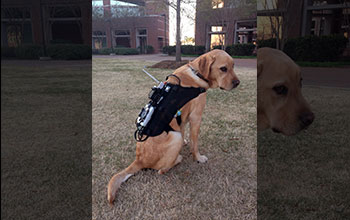Multimedia Gallery
Customized dog harness allows computer to train dogs autonomously
This customized dog harness is equipped with technologies that allows a computer to train the dog autonomously, with the computer effectively responding to the dog based on its body language.
More about this image
The customized dog harness developed at North Carolina State University (NC State) fits comfortably on the dog and can monitor the dog’s posture and body language, with the computer effectively responding to the dog based on these factors. A computer the size of a deck of cards is incorporated into the harness and transmits sensor data wirelessly.
"Our approach can be used to train dogs efficiently and effectively," says David Roberts, an assistant professor of computer science at NC State and co-author of a paper on the work. "We use sensors in custom dog harnesses to monitor a dog’s posture, and the computer reinforces the correct behavior quickly and with near-perfect consistency."
For the study, the researchers wrote an algorithm that triggers a beeping sound--and the release of dog treats from a nearby dispenser--if the sensors on the harness detects a change in the dog's position; for example, if the dog went from standing to sitting.
The researchers had to ensure that the reinforcement was given shortly after the desired posture was exhibited, and that rewards were only given for the correct posture. The researchers found if the algorithm ran long enough to ensure the correct posture with 100 percent certainty, the reinforcement was given too late to be effective for training purposes. But if the reinforcement was given immediately, there was a high rate of rewarding the wrong posture.
Working with 16 volunteers and their dogs, the researchers optimized the algorithm and found the best possible combination of speed and accuracy. Next, they compared the algorithm’s timing and accuracy to that of an expert human trainer and found the algorithm to be highly accurate, rewarding the appropriate behavior 96 percent of the time. But the human trainer was better--with a 100 percent accuracy rate.
However, while the average response time was about the same for both algorithm and trainer, there was a lot of variation in the time of response from the trainer. The algorithm was incredibly consistent. "That variation matters, because consistency is fundamentally important for all animal training," says Roberts.
The research was supported by a grant from the National Science Foundation (grant CNS 13-29738).
To learn more, see the NSF News From the Field story New tech uses hardware, software to train dogs more efficiently. (Date image taken: March 2016; date originally posted to NSF Multimedia Gallery: Oct. 4, 2016)
Credit: Alper Bozkurt/North Carolina State University
Images and other media in the National Science Foundation Multimedia Gallery are available for use in print and electronic material by NSF employees, members of the media, university staff, teachers and the general public. All media in the gallery are intended for personal, educational and nonprofit/non-commercial use only.
Images credited to the National Science Foundation, a federal agency, are in the public domain. The images were created by employees of the United States Government as part of their official duties or prepared by contractors as "works for hire" for NSF. You may freely use NSF-credited images and, at your discretion, credit NSF with a "Courtesy: National Science Foundation" notation.
Additional information about general usage can be found in Conditions.
Also Available:
Download the high-resolution JPG version of the image. (5.7 MB)
Use your mouse to right-click (Mac users may need to Ctrl-click) the link above and choose the option that will save the file or target to your computer.



